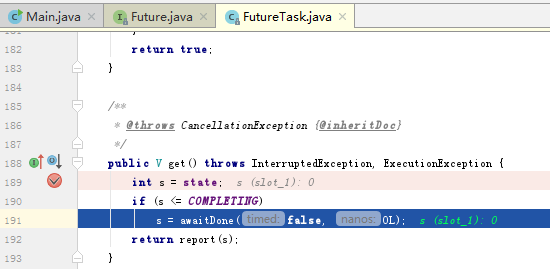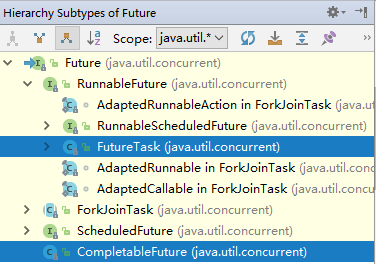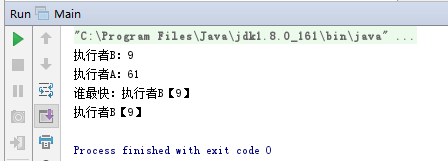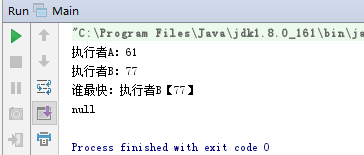Future
从JDK1.5开始,提供了Future来表示异步计算的结果,一般它需要结合ExecutorService(执行者)和Callable(任务)来使用。
示例
import java.util.*; import java.util.concurrent.*; public class Main { public static void main(String[] args) throws Exception { ThreadPoolExecutor executor = new ThreadPoolExecutor(3, 6, 60L, TimeUnit.SECONDS, new ArrayBlockingQueue<>(10)); Future<Integer> future = executor.submit(() -> { // 故意耗时 Thread.sleep(5000); return new Random().nextInt(100); }); System.out.println(future.get()); System.out.println("如果get是阻塞的,则此消息在数据之后输出"); executor.shutdown(); } }
输出

即使异步任务等待了5秒,也依然先于消息输出,由此证明get方法是阻塞的。
Future只是个接口,实际上返回的类是FutureTask:

/** * 表示此任务的运行状态。最初是NEW == 0。运行状态仅在set、setException和cancel方法中转换为终端状态。 * * 可能的状态转换: * NEW -> COMPLETING -> NORMAL * NEW -> COMPLETING -> EXCEPTIONAL * NEW -> CANCELLED * NEW -> INTERRUPTING -> INTERRUPTED */ private volatile int state; private static final int NEW = 0; private static final int COMPLETING = 1; private static final int NORMAL = 2; private static final int EXCEPTIONAL = 3; private static final int CANCELLED = 4; private static final int INTERRUPTING = 5; private static final int INTERRUPTED = 6; public V get() throws InterruptedException, ExecutionException { int s = state; // 如果当前状态是COMPLETING及其之下的状态,则需要进入awaitDone方法阻塞等待任务完成。 if (s <= COMPLETING) s = awaitDone(false, 0L); return report(s); }
CompletableFuture
JDk1.8引入了CompletableFuture,它实际上也是Future的实现类。这里可以得出:
1. 面试问Future和CompletableFuture的区别实际上是不严谨的,因为一个是接口一个是其实现类。
2. 问区别实际上是问FutureTask和CompletableFuture的区别,或者说CompletableFuture有哪些新特性,能完成Future不能完成的工作。

首先看类定义,可以看到,实现了CompletionStage接口,这个接口是所有的新特性了
public class CompletableFuture<T> implements Future<T>, CompletionStage<T>
对于CompletableFuture有四个执行异步任务的方法:
public static <U> CompletableFuture<U> supplyAsync(Supplier<U> supplier) public static <U> CompletableFuture<U> supplyAsync(Supplier<U> supplier, Executor executor) public static CompletableFuture<Void> runAsync(Runnable runnable) public static CompletableFuture<Void> runAsync(Runnable runnable, Executor executor)
1. 如果我们指定线程池,则会使用我么指定的线程池;如果没有指定线程池,默认使用ForkJoinPool.commonPool()作为线程池。
2. supply开头的带有返回值,run开头的无返回值。
1. 执行异步任务(supplyAsync / runAsync)
import java.util.Random; import java.util.concurrent.ArrayBlockingQueue; import java.util.concurrent.CompletableFuture; import java.util.concurrent.ThreadPoolExecutor; import java.util.concurrent.TimeUnit; public class Main { public static void main(String[] args) throws Exception { ThreadPoolExecutor executor = new ThreadPoolExecutor(3, 6, 60L, TimeUnit.SECONDS, new ArrayBlockingQueue<>(10)); CompletableFuture<Integer> future = CompletableFuture.supplyAsync(() -> { return new Random().nextInt(100); }, executor); System.out.println(future.get()); executor.shutdown(); } }
以上仅仅返回个随机数,如果我们要利用计算结果进一步处理呢?
2. 结果转换(thenApply / thenApplyAsync)
// 同步转换 public <U> CompletableFuture<U> thenApply(Function<? super T,? extends U> fn) // 异步转换,使用默认线程池 public <U> CompletableFuture<U> thenApplyAsync(Function<? super T,? extends U> fn) // 异步转换,使用指定线程池 public <U> CompletableFuture<U> thenApplyAsync(Function<? super T,? extends U> fn, Executor executor)
import java.util.Random; import java.util.concurrent.ArrayBlockingQueue; import java.util.concurrent.CompletableFuture; import java.util.concurrent.ThreadPoolExecutor; import java.util.concurrent.TimeUnit; public class Main { public static void main(String[] args) throws Exception { ThreadPoolExecutor executor = new ThreadPoolExecutor(3, 6, 60L, TimeUnit.SECONDS, new ArrayBlockingQueue<>(10)); CompletableFuture<Integer> future = CompletableFuture // 执行异步任务 .supplyAsync(() -> { return new Random().nextInt(100); }, executor) // 对上一步的结果进行处理 .thenApply(n -> { try { Thread.sleep(2000); } catch (InterruptedException e) { e.printStackTrace(); } int res = new Random().nextInt(100); System.out.println(String.format("如果是同步的,这条消息应该先输出。上一步结果:%s,新加:%s", n, res)); return n + res; }); System.out.println("我等了你2秒"); System.out.println(future.get()); executor.shutdown(); } }
输出:

如果把thenApply换成thenApplyAsync,则会输出:

处理完任务以及结果,该去消费了
3. 消费而不影响最终结果(thenAccept / thenRun / thenAcceptBoth)
public CompletableFuture<Void> thenAccept(Consumer<? super T> action) public CompletableFuture<Void> thenAcceptAsync(Consumer<? super T> action) public CompletableFuture<Void> thenAcceptAsync(Consumer<? super T> action, Executor executor) public CompletableFuture<Void> thenRun(Runnable action) public CompletableFuture<Void> thenRunAsync(Runnable action) public CompletableFuture<Void> thenRunAsync(Runnable action, Executor executor) public <U> CompletableFuture<Void> thenAcceptBoth(CompletionStage<? extends U> other, BiConsumer<? super T, ? super U> action) public <U> CompletableFuture<Void> thenAcceptBothAsync(CompletionStage<? extends U> other, BiConsumer<? super T, ? super U> action) public <U> CompletableFuture<Void> thenAcceptBothAsync(CompletionStage<? extends U> other, BiConsumer<? super T, ? super U> action, Executor executor)
这三种的区别是:
thenAccept:能够拿到并利用执行结果
thenRun:不能够拿到并利用执行结果,只是单纯的执行其它任务
thenAcceptBoth:能传入另一个stage,然后把另一个stage的结果和当前stage的结果作为参数去消费。
import java.util.Random; import java.util.concurrent.ArrayBlockingQueue; import java.util.concurrent.CompletableFuture; import java.util.concurrent.ThreadPoolExecutor; import java.util.concurrent.TimeUnit; public class Main { public static void main(String[] args) throws Exception { ThreadPoolExecutor executor = new ThreadPoolExecutor(3, 6, 60L, TimeUnit.SECONDS, new ArrayBlockingQueue<>(10)); CompletableFuture<Integer> future = CompletableFuture // 执行异步任务 .supplyAsync(() -> { return new Random().nextInt(100); }, executor) // 对上一步的结果进行处理 .thenApplyAsync(n -> { try { Thread.sleep(2000); } catch (InterruptedException e) { e.printStackTrace(); } int res = new Random().nextInt(100); System.out.println(String.format("如果是同步的,这条消息应该先输出。上一步结果:%s,新加:%s", n, res)); return n + res; }); // 单纯的消费执行结果,注意这个方法是不会返回计算结果的——CompletableFuture<Void> CompletableFuture<Void> voidCompletableFuture = future.thenAcceptAsync(n -> { System.out.println("单纯消费任务执行结果:" + n); }); // 这个无法消费执行结果,没有传入的入口,只是在当前任务执行完毕后执行其它不相干的任务 future.thenRunAsync(() -> { System.out.println("我只能执行其它工作,我得不到任务执行结果"); }, executor); // 这个方法会接受其它CompletableFuture返回值和当前返回值 future.thenAcceptBothAsync(CompletableFuture.supplyAsync(() -> { return "I'm Other Result"; }), (current, other) -> { System.out.println(String.format("Current:%s,Other:%s", current, other)); }); System.out.println("我等了你2秒"); System.out.println(future.get()); executor.shutdown(); } }
结果:

如果我要组合两个任务呢?
4. 组合任务(thenCombine / thenCompose)
public <U,V> CompletionStage<V> thenCombine(CompletionStage<? extends U> other, BiFunction<? super T,? super U,? extends V> fn) public <U,V> CompletionStage<V> thenCombineAsync(CompletionStage<? extends U> other, BiFunction<? super T,? super U,? extends V> fn) public <U,V> CompletionStage<V> thenCombineAsync(CompletionStage<? extends U> other, BiFunction<? super T,? super U,? extends V> fn, Executor executor) public <U> CompletionStage<U> thenCompose(Function<? super T, ? extends CompletionStage<U>> fn) public <U> CompletionStage<U> thenComposeAsync(Function<? super T, ? extends CompletionStage<U>> fn) public <U> CompletionStage<U> thenComposeAsync(Function<? super T, ? extends CompletionStage<U>> fn, Executor executor)
这两种区别:主要是返回类型不一样。
thenCombine:至少两个方法参数,一个为其它stage,一个为用户自定义的处理函数,函数返回值为结果类型。
thenCompose:至少一个方法参数即处理函数,函数返回值为stage类型。
先看thenCombine
import java.util.Random; import java.util.concurrent.ArrayBlockingQueue; import java.util.concurrent.CompletableFuture; import java.util.concurrent.ThreadPoolExecutor; import java.util.concurrent.TimeUnit; public class Main { public static void main(String[] args) throws Exception { ThreadPoolExecutor executor = new ThreadPoolExecutor(3, 6, 60L, TimeUnit.SECONDS, new ArrayBlockingQueue<>(10)); CompletableFuture<Integer> otherFuture = CompletableFuture // 执行异步任务 .supplyAsync(() -> { int result = new Random().nextInt(100); System.out.println("任务A:" + result); return result; }, executor); CompletableFuture<Integer> future = CompletableFuture // 执行异步任务 .supplyAsync(() -> { int result = new Random().nextInt(100); System.out.println("任务B:" + result); return result; }, executor) .thenCombineAsync(otherFuture, (current, other) -> { int result = other + current; System.out.println("组合两个任务的结果:" + result); return result; }); System.out.println(future.get()); executor.shutdown(); } }
执行结果:

再来看thenCompose
import java.util.Random; import java.util.concurrent.ArrayBlockingQueue; import java.util.concurrent.CompletableFuture; import java.util.concurrent.ThreadPoolExecutor; import java.util.concurrent.TimeUnit; public class Main { public static void main(String[] args) throws Exception { ThreadPoolExecutor executor = new ThreadPoolExecutor(3, 6, 60L, TimeUnit.SECONDS, new ArrayBlockingQueue<>(10)); CompletableFuture<Integer> future = CompletableFuture // 执行异步任务 .supplyAsync(() -> { int result = new Random().nextInt(100); System.out.println("任务A:" + result); return result; }, executor) .thenComposeAsync((current) -> { return CompletableFuture.supplyAsync(() -> { int b = new Random().nextInt(100); System.out.println("任务B:" + b); int result = b + current; System.out.println("组合两个任务的结果:" + result); return result; }, executor); }); System.out.println(future.get()); executor.shutdown(); } }
输出:

注意这两个输出虽然一样,但是用法不一样。
5. 快者优先(applyToEither / acceptEither)
有个场景,如果我们有多条渠道去完成同一种任务,那么我们肯定选择最快的那个。
public <U> CompletionStage<U> applyToEither(CompletionStage<? extends T> other, Function<? super T, U> fn) public <U> CompletionStage<U> applyToEitherAsync(CompletionStage<? extends T> other, Function<? super T, U> fn) public <U> CompletionStage<U> applyToEitherAsync(CompletionStage<? extends T> other, Function<? super T, U> fn, Executor executor) public CompletionStage<Void> acceptEither(CompletionStage<? extends T> other, Consumer<? super T> action) public CompletionStage<Void> acceptEitherAsync(CompletionStage<? extends T> other, Consumer<? super T> action) public CompletionStage<Void> acceptEitherAsync(CompletionStage<? extends T> other, Consumer<? super T> action, Executor executor)
这两种区别:仅仅是一个有返回值,一个没有(Void)
先看applyToEither
import java.util.Random; import java.util.concurrent.ArrayBlockingQueue; import java.util.concurrent.CompletableFuture; import java.util.concurrent.ThreadPoolExecutor; import java.util.concurrent.TimeUnit; public class Main { public static void main(String[] args) throws Exception { ThreadPoolExecutor executor = new ThreadPoolExecutor(3, 6, 60L, TimeUnit.SECONDS, new ArrayBlockingQueue<>(10)); CompletableFuture<String> otherFuture = CompletableFuture .supplyAsync(() -> { int result = new Random().nextInt(100); System.out.println("执行者A:" + result); try { // 故意A慢了一些 Thread.sleep(1000); } catch (InterruptedException e) { e.printStackTrace(); } return "执行者A【" + result + "】"; }, executor); CompletableFuture<String> future = CompletableFuture .supplyAsync(() -> { int result = new Random().nextInt(100); System.out.println("执行者B:" + result); return "执行者B【" + result + "】"; }, executor) .applyToEither(otherFuture, (faster) -> { System.out.println("谁最快:" + faster); return faster; }); System.out.println(future.get()); executor.shutdown(); } }
输出:

再看acceptEither
import java.util.Random; import java.util.concurrent.ArrayBlockingQueue; import java.util.concurrent.CompletableFuture; import java.util.concurrent.ThreadPoolExecutor; import java.util.concurrent.TimeUnit; public class Main { public static void main(String[] args) throws Exception { ThreadPoolExecutor executor = new ThreadPoolExecutor(3, 6, 60L, TimeUnit.SECONDS, new ArrayBlockingQueue<>(10)); CompletableFuture<String> otherFuture = CompletableFuture .supplyAsync(() -> { int result = new Random().nextInt(100); System.out.println("执行者A:" + result); try { // 故意A慢了一些 Thread.sleep(1000); } catch (InterruptedException e) { e.printStackTrace(); } return "执行者A【" + result + "】"; }, executor); CompletableFuture<Void> future = CompletableFuture .supplyAsync(() -> { int result = new Random().nextInt(100); System.out.println("执行者B:" + result); return "执行者B【" + result + "】"; }, executor) .acceptEither(otherFuture, (faster) -> { System.out.println("谁最快:" + faster); }); System.out.println(future.get()); executor.shutdown(); } }
输出:

6. 异常处理(exceptionally / whenComplete / handle)
public CompletionStage<T> exceptionally(Function<Throwable, ? extends T> fn); public CompletionStage<T> whenComplete(BiConsumer<? super T, ? super Throwable> action); public CompletionStage<T> whenCompleteAsync(BiConsumer<? super T, ? super Throwable> action); public CompletionStage<T> whenCompleteAsync(BiConsumer<? super T, ? super Throwable> action, Executor executor); public <U> CompletionStage<U> handle(BiFunction<? super T, Throwable, ? extends U> fn); public <U> CompletionStage<U> handleAsync(BiFunction<? super T, Throwable, ? extends U> fn); public <U> CompletionStage<U> handleAsync(BiFunction<? super T, Throwable, ? extends U> fn,Executor executor);
exceptionally
import java.util.concurrent.ArrayBlockingQueue; import java.util.concurrent.CompletableFuture; import java.util.concurrent.ThreadPoolExecutor; import java.util.concurrent.TimeUnit; public class Main { public static void main(String[] args) throws Exception { ThreadPoolExecutor executor = new ThreadPoolExecutor(3, 6, 60L, TimeUnit.SECONDS, new ArrayBlockingQueue<>(10)); CompletableFuture<String> future = CompletableFuture .supplyAsync(() -> { if (true){ throw new RuntimeException("Error!!!"); } return "Hello"; }, executor) // 处理上一步发生的异常 .exceptionally(e -> { System.out.println("处理异常:" + e.getMessage()); return "处理完毕!"; }); System.out.println(future.get()); executor.shutdown(); } }
输出:

whenComplete
import java.util.concurrent.ArrayBlockingQueue; import java.util.concurrent.CompletableFuture; import java.util.concurrent.ThreadPoolExecutor; import java.util.concurrent.TimeUnit; public class Main { public static void main(String[] args) throws Exception { ThreadPoolExecutor executor = new ThreadPoolExecutor(3, 6, 60L, TimeUnit.SECONDS, new ArrayBlockingQueue<>(10)); CompletableFuture<String> future = CompletableFuture .supplyAsync(() -> { if (true){ throw new RuntimeException("Error!!!"); } return "Hello"; }, executor) // 处理上一步发生的异常 .whenComplete((result,ex) -> { // 这里等待为了上一步的异常输出完毕 try { Thread.sleep(100); } catch (InterruptedException e) { e.printStackTrace(); } System.out.println("上一步结果:" + result); System.out.println("处理异常:" + ex.getMessage()); }); System.out.println(future.get()); executor.shutdown(); } }
输出结果:

可以看见,用whenComplete对异常情况不是特别友好。
handle
import java.util.concurrent.ArrayBlockingQueue; import java.util.concurrent.CompletableFuture; import java.util.concurrent.ThreadPoolExecutor; import java.util.concurrent.TimeUnit; public class Main { public static void main(String[] args) throws Exception { ThreadPoolExecutor executor = new ThreadPoolExecutor(3, 6, 60L, TimeUnit.SECONDS, new ArrayBlockingQueue<>(10)); CompletableFuture<String> future = CompletableFuture .supplyAsync(() -> { if (true){ throw new RuntimeException("Error!!!"); } return "Hello"; }, executor) // 处理上一步发生的异常 .handle((result,ex) -> { System.out.println("上一步结果:" + result); System.out.println("处理异常:" + ex.getMessage()); return "Value When Exception Occurs"; }); System.out.println(future.get()); executor.shutdown(); } }
输出:

综上,如果单纯要处理异常,那就用exceptionally;如果还想处理结果(没有异常的情况),那就用handle,比whenComplete友好一些,handle不仅能处理异常还能返回一个异常情况的默认值。
对比
Future:我们的目的都是获取异步任务的结果,但是对于Future来说,只能通过get方法或者死循环判断isDone来获取。异常情况就更是难办。
CompletableFuture:只要我们设置好回调函数即可实现:
1. 只要任务完成,即执行我们设置的函数(不用再去考虑什么时候任务完成)
2. 如果发生异常,同样会执行我们处理异常的函数,甚至连默认返回值都有(异常情况处理更加省力)
3. 如果有复杂任务,比如依赖问题,组合问题等,同样可以写好处理函数来处理(能应付复杂任务的处理)